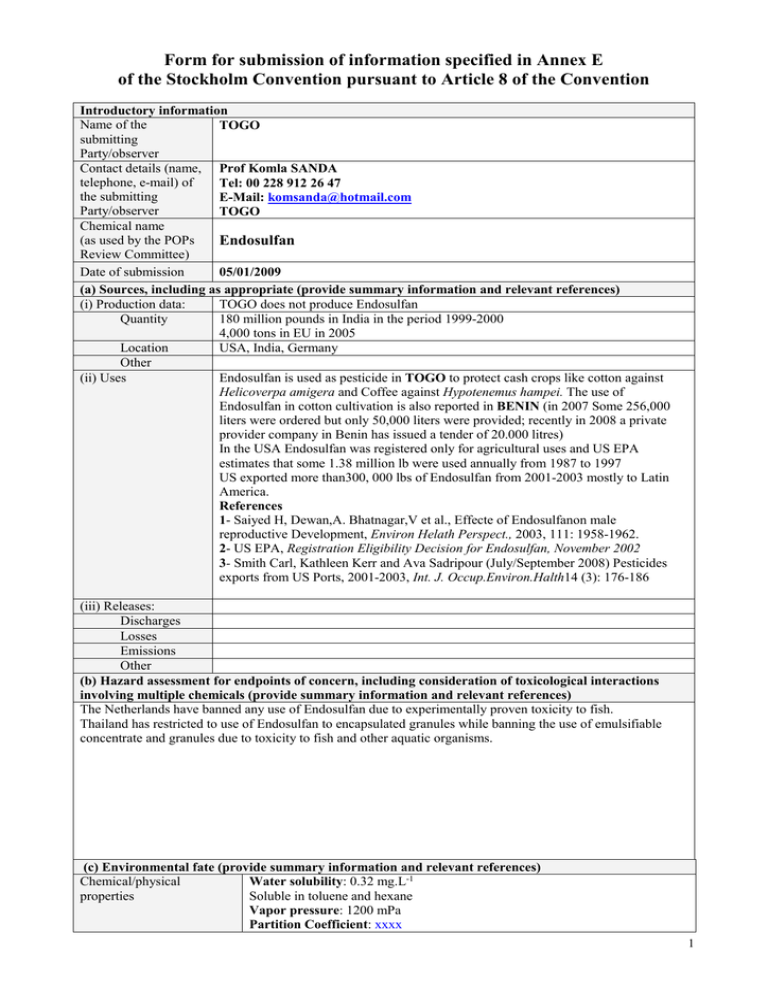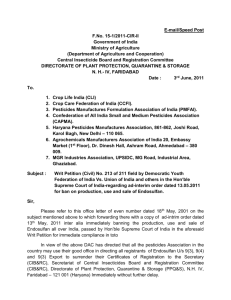Form for submission of information specified in Annex E
advertisement

Form for submission of information specified in Annex E of the Stockholm Convention pursuant to Article 8 of the Convention Introductory information Name of the TOGO submitting Party/observer Contact details (name, Prof Komla SANDA telephone, e-mail) of Tel: 00 228 912 26 47 the submitting E-Mail: komsanda@hotmail.com Party/observer TOGO Chemical name (as used by the POPs Endosulfan Review Committee) Date of submission 05/01/2009 (a) Sources, including as appropriate (provide summary information and relevant references) (i) Production data: TOGO does not produce Endosulfan Quantity 180 million pounds in India in the period 1999-2000 4,000 tons in EU in 2005 Location USA, India, Germany Other (ii) Uses Endosulfan is used as pesticide in TOGO to protect cash crops like cotton against Helicoverpa amigera and Coffee against Hypotenemus hampei. The use of Endosulfan in cotton cultivation is also reported in BENIN (in 2007 Some 256,000 liters were ordered but only 50,000 liters were provided; recently in 2008 a private provider company in Benin has issued a tender of 20.000 litres) In the USA Endosulfan was registered only for agricultural uses and US EPA estimates that some 1.38 million lb were used annually from 1987 to 1997 US exported more than300, 000 lbs of Endosulfan from 2001-2003 mostly to Latin America. References 1- Saiyed H, Dewan,A. Bhatnagar,V et al., Effecte of Endosulfanon male reproductive Development, Environ Helath Perspect., 2003, 111: 1958-1962. 2- US EPA, Registration Eligibility Decision for Endosulfan, November 2002 3- Smith Carl, Kathleen Kerr and Ava Sadripour (July/September 2008) Pesticides exports from US Ports, 2001-2003, Int. J. Occup.Environ.Halth14 (3): 176-186 (iii) Releases: Discharges Losses Emissions Other (b) Hazard assessment for endpoints of concern, including consideration of toxicological interactions involving multiple chemicals (provide summary information and relevant references) The Netherlands have banned any use of Endosulfan due to experimentally proven toxicity to fish. Thailand has restricted to use of Endosulfan to encapsulated granules while banning the use of emulsifiable concentrate and granules due to toxicity to fish and other aquatic organisms. (c) Environmental fate (provide summary information and relevant references) Chemical/physical Water solubility: 0.32 mg.L-1 properties Soluble in toluene and hexane Vapor pressure: 1200 mPa Partition Coefficient: xxxx 1 Adsoprtion Coefficient (Koc): 12,400 cm3.g-1 log Kow: 3,6. This value is high enough to consider endosulfan a lipohilic substance Persistence Breakdown in soil and groundwater: Endosulfan is moderately persistent in the soil environment: average field half-life: 50 days; Half-life for alpha-isomer: 35 days; Half-life: 150 days for the beta-isomer under neutral conditions. Endosulfan is broken down in soil by fungi and bacteria. It has a moderate capacity to adhere or adsorb to soil. Transport is likely to be ensured by adsorption to soil particles in surface runoff. Not likely to be mobile or to pose threat to groundwater, but has been detected in well water in California Breakdown in water In raw river water both isomers disappeared in four weeks, breakdown starting within the first week. In water neutral conditions favour break down in contrast with acidic or alkaline conditions. Large mounts of Endosulfan can be found in surface water near application areas. It has been also detected in surface water at very law concentration throughout a country. Breakdown in vegetation: In plants, Endosulfan is rapidly broken down in the corresponding sulphate. On most fruits and vegetables, 50 % of the parent residue is lost within 3 to 7 days. Endosulfan and its breakdown products have been detected in vegetables (0.0005-0.013 ppm) in tobacco, in various seafood (0.2 ppt-1.7 ppb) and in milk Fate in humans and animals: Endosulfan is rapidly degraded into mainly watersoluble compounds and eliminated in mammals with very little absorption in the gastrointestinal tract. In rabbits, the beta-isomer is cleared from blood plasma more quickly than the alpha-isomer, with reported blood half-lives of approximately 6 hours and 10 days, respectively, which may account in part for the observed differences in toxicity. The metabolites are dependent on the mixture of isomers and the route of exposure. Most of the endosulfan seems to leave the body within a few days to a few weeks. References: 1- Kidd,H James D. R., Eds. The agrochemical handbook, Third Edition. Royal Society of Chemistry Information Service, Cambridge, UK,1991 (as updated). 6-10 2- Howard, P.H., Ed. Handbook of Environmental Fate and Exposure data for Organic chemicals. Pesticides. Lewis Publishers, Chelsea, MI,1001.6-13 3- Wauchope, R.D., Buttler,T. M., Hornsby, A. G. Augustijin Beckers,P. W. an Burt,J.P. SC/ARAS/CES Pesticides properties database for environmental decision making. Rev. Environ.contam.Toxicol.123/ 1-157, 1993.6-15 4- http://fr.wikipedia.org.wiki/Endosulfan: 29/12/2008 5- Smith, A.G. Chlorinated hydrocarbon Insecticides. In Handbook of Pesticides Toxicology. Hayes, W. J. Jr. and Laws, E. R. Jr.;Eds, Academic Press Inc., NY,1991. 6-13. How are chemical/physical Endosulfan degrades into Endosulfan Sulfate (fromed from aerobic biological properties and persistence oxidation) which is toxic and much more persistent than either of the parent linked to environmental chemicals and Endosulfan diol (formed in anaerobic flooded soils from transport, transfer within biological and chemical hydrolysis) which non-toxic. and between environmental compartments, degradation and transformation to other chemicals? Bio-concentration or bioBioconcentration factor (BCF) in Fish Yellow Tetra: 11,583. accumulation factor, based Ref: Jonsson Claudio M. and Toledo Maria Cecilia F. (1993) Bioaccumulation on measured values (unless and Elimination of Endosulfan in the fish Yellow Tetra (Hypessobrycon monitoring data are judged bifacsiatus) Bull Environ. Contam. Toxicol 50:572-577 to meet this need) (d) Monitoring data (provide summary information and relevant references) 2 Contamination of drinking water, Cowpea (Vigna unguiculata) maize (Zea mays) by Endosulfan has very recently been investigated in Southern Togo in areas devoted to the production of the main national cash crops which are cotton, coffee and cocoa. In river water, the residue levels ranged from 0.29 to 0.32 g.L-1 and 0.25 to 0.40 g.L-1 respectively for α- and β-Endosulfan. This contamination exceeded the limit value set by the EU (0.1g.L-1). In well water contamination was much lower as it did not exceed 0.05 g.L-1. In Cowpea, the residue level of α-Endosulfan was 98.80 g.L-1 and that of β-Endosulfan 88.51 g.L-1. Maize which is the most common food was also found significantly contaminated by α-Endosulfan (34.74 g.L-1) and β-Endosulfan (65.71 g.L-1). Reference: G.Mawussi, K. Sanda G. Merlina and E. Pinelli (2008)- Assessment of average exposure to organochlorine pesticides in southern Togo from water maize (Zea mays) and and cowpea (Vigna unguilata); Food Additives and Contaminants.p1-7. (in press). (e) Exposure in local areas (provide summary information and relevant references) General As a result of long-range environmental transport Information regarding bioavailability (f) National and international risk evaluations, assessments or profiles and labelling information and hazard classifications, as available (provide summary information and relevant references) There no data yet available at the national level International level T: Toxic N: Hazardous for the environment R24/25: Toxic by contact with skin and by inhalation R36: Irritative to eyes R50/53: Highly toxic for aquatic organisms, possible long-term adverse effects on aquatic environment (g) Status of the chemical under international conventions 1- CILSS member States (Burkina Faso, Cap Verde, Chad, The Gambia, Guinea Bissau, Mali, Mauritania, Niger and Senegal) have banned the use of pesticides formulation including Endosulfan as active ingredient since July 2006 The deadline set up for termination of the use of existing stocks is 31/12/2008. 2- Endosulfan is not listed yet listed in Annex III under the Rotterdam Convention 3- Endosulfan is listed as a POP under the Convention on Long-Range Transboundary Air Pollution (LRTAP) ___________________________ 3
